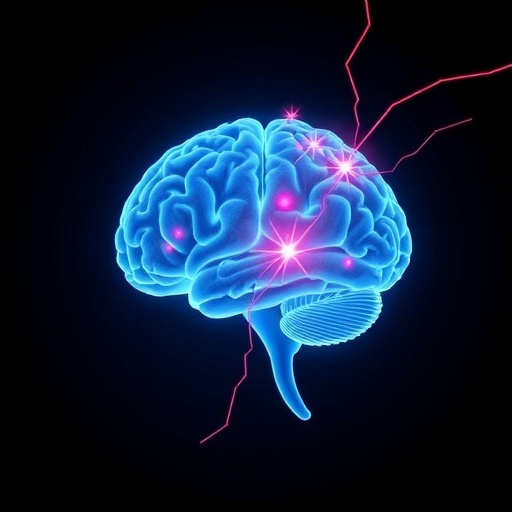Recent research in the field of geriatric mental health has shed light on the complex interplay between cognitive decline, neuroimaging markers, and suicidal tendencies in older adults grappling with depression. One noteworthy study, conducted by a team led by Lee et al., presents compelling findings about white matter hyperintensities (WMHs) and their relationship with cognition and suicide risk among late-life depression patients. This exploratory analysis, published in BMC Geriatrics, aims not only to deepen our understanding of the mental health challenges faced by older adults but also to offer insights that could inform clinical practices.
As individuals age, the prevalence of depression often increases, becoming a harrowing reality for many in their later years. This condition is frequently compounded by cognitive impairments and physical health challenges. Lee and colleagues have focused their investigation on late-life depression, where patients may suffer from a dual burden of mental health issues and cognitive decline, creating a complex clinical picture. Their groundbreaking study brings to the forefront the significance of WMHs as potential biomarkers that could help delineate risks associated with suicide in this vulnerable population.
WMHs, observable through advanced neuroimaging techniques such as magnetic resonance imaging (MRI), appear as bright spots on scans representing areas of increased water content in the brain’s white matter. These changes are often linked to small vessel disease and other forms of cerebrovascular pathology. The study conducted by Lee and his team delves into how these hyperintensities correlate with cognitive function and how they might serve as indicators of heightened suicide risk among those suffering from late-life depression.
In their research, Lee et al. conducted a thorough assessment of cognitive abilities alongside neuroimaging data to investigate the presence and extent of WMHs in their participants. The findings revealed a troubling relationship between the severity of WMHs and cognitive decline. As WMH loads increased, participants demonstrated notable deficits in various cognitive domains, including attention and executive function. This decline poses significant implications, as cognitive impairment may exacerbate depressive symptoms, leading to an increased risk of suicidal ideation and attempts.
Through their explorative lens, the researchers highlighted the potential for WMHs to act as significant predictors of suicidal thoughts and behaviors in older adults with depression. For clinicians, this insight materializes as an essential warning signal — the presence of substantial WMHs could necessitate a more comprehensive assessment of mental health, tailored interventions, and close monitoring of suicide risk in patients undergoing treatment for late-life depression.
The implications of Lee et al.’s findings transcend the confines of academic interest. By understanding the neurobiological underpinnings illustrated by the relationship between WMHs, cognition, and suicidal risk, healthcare providers may improve preventative strategies and therapeutic approaches. The study advocates for interdisciplinary collaboration, merging psychiatry, geriatrics, and neurology, to address the multifaceted aspects of late-life depression effectively.
In light of the study’s findings, mid to long-term treatment plans for older adults experiencing depression should prioritize regular neuroimaging assessments, enabling clinicians to visualize the presence of WMHs while diligently monitoring cognitive function. These insights suggest a paradigm shift in how aging and mental health are approached, fostering a more holistic view of patient care that considers both physiological and psychological dimensions.
Moreover, the research highlights the urgency of addressing social stigma surrounding mental illness in older adults. Many individuals in this demographic endure isolation and silence their distress, potentially leading to spiraling mental health crises. By drawing attention to the interplay of neurological indicators and mental health, the findings encourage open discussions about seeking help and treatment, thereby normalizing mental health dialogues among the elderly population.
As we contemplate the ramifications of these findings, it becomes clear that there is a dire need for increasing public awareness regarding late-life depression and its associated risks. Community resources, educational programs, and support networks tailored to the elderly can prove invaluable in bridging gaps in knowledge and combating the silent struggles many endure.
This exploratory study is a stepping stone toward more extensive research on aging, cognition, and mental health. Moving forward, large-scale longitudinal studies could illuminate trends and causal relationships while refining the application of WMHs as biomarkers for mental health outcomes. In pursuit of alleviating the burden of late-life depression, the medical community must embrace innovative research alongside actionable interventions.
In conclusion, Lee et al.’s study serves as a clarion call to embrace a more integrated approach to mental health in the elderly. The intricate connections unearthed between cognitive decline, WMHs, and suicidal risk illuminate a path forward, one where understanding neurological changes could revolutionize the ways we treat and support aging populations. As we advance our grasp on these complexities, perhaps we can pave the way toward reducing suicide rates and enhancing the quality of life for older adults grappling with depression.
The urgent messages encoded within this study resonate throughout the academic and clinical spheres, ultimately weaving into the societal fabric at large. We owe it to future generations to prioritize mental health as a vital component of well-being, empowering both individuals and communities in the face of aging and mental health challenges.
In summary, as the global population ages, defining the relationship between cognitive decline and mental health will become increasingly crucial. Research like that of Lee et al. emphasizes the need for early detection and intervention strategies that can support older adults in navigating their psychological landscape with resilience and support.
Subject of Research: The relationship between white matter hyperintensities, cognition, and suicide risk in late-life depression patients.
Article Title: Cognition, white matter hyperintensities and suicide risk in late-life depression patients: an exploratory study.
Article References:
Lee, YT., Huang, LK., Sajatovic, M. et al. Cognition, white matter hyperintensities and suicide risk in late-life depression patients: an exploratory study.
BMC Geriatr 25, 686 (2025). https://doi.org/10.1186/s12877-025-06358-x
Image Credits: AI Generated
DOI: 10.1186/s12877-025-06358-x
Keywords: Late-life depression, cognitive decline, white matter hyperintensities, suicide risk, neuroimaging, geriatric mental health.




